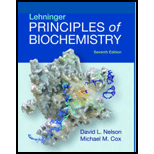
Concept explainers
(a)
To determine: The amino acid replacements that would be consistent with the genetic code if the replacements were caused by a single base change and amino acid replacements that cannot be the result of a single-base mutation.
Introduction:
The codons UUU, UUC, UUA, and UUG codes for the amino acid phenylalanine and the codons CUU, CUC, CUA and CUG codes for the amino acids leucine.
(b)
To determine: The amino acid replacements that would be consistent with the genetic code if the replacements were caused by a single base change and amino acid replacements which cannot be the result of a single-base mutation.
Introduction:
The lysine and alanine both are amino acids and are found in the human body. The lysine is encoded by AAA and AAG codons. The codons GGU, GCC, GGA and GCG encodes for alanine.
(c)
To determine: The amino acids replacement that would be consistent with the genetic code if the replacements were caused by a single base change and amino acid replacements which cannot be the result of a single-base mutation.
Introduction:
The codons which code for alanine amino acid are GCU, GCC, GCA, and GCG. The codons which code for threonine are ACU, ACC, ACA and ACG. The last two bases in the codons are similar in amino acids, alanine and threonine.
(d)
To determine: The amino acid replacements that would be consistent with the genetic code if the replacements were caused by a single base change and amino acid replacements which cannot be the result of a single-base mutation.
Introduction:
The codons which code for amino acid phenylalanine are UUU, UUC, UUA and UUG. Lysine is encoded by the codons AAA and AAG. The conversion does not involve the change in the single base.
(e)
To determine: The amino acid replacements that would be consistent with the genetic code if the replacements were caused by a single base change and amino acid replacements which cannot be result of a single-base mutation.
Introduction:
The amino acid isoleucine is encoded by the amino acids AUU and AUA. The amino acid leucine is encoded by codons CUU, CUC and CUA. The change in the single base pair and whole bases are same in both amino acids.
(f)
To determine: The amino acid replacements that would be consistent with the genetic code if the replacements were caused by a single base change and amino acid replacements which cannot be the result of a single-base mutation. Give reason.
Introduction:
The amino acid histidine is encoded by the codons CAU and CAC. The amino acid glutamic acid is encoded by the codons GAA and GAG. All bases are different in both the amino acids.
Want to see the full answer?
Check out a sample textbook solution
Chapter 27 Solutions
Lehninger Principles of Biochemistry
- Show the fate of the hydrogen on carbon-2 of glucose.arrow_forwardImagine that aldolase can react with the seven carbon molecule Sedoheptulose-1,7-bisphosphate (below). Use the mechanism to predict the two products generated.arrow_forwardShow the mechanisms of PGK and PFK-1. How are they different?arrow_forward
- Show the fate of the proton on the 4-Oxygen molecule of F-1,6-BP.arrow_forwardSodium borohydride (NaBH4) is a potent inhibitor of aldolase. It is known to ONLY inhibit theenzyme when it is complexed with substrate. Treatment of the enzyme alone has no effect.What is the mechanism for this inhibition?arrow_forwardA non-hydrolysable ATP (AMPPNP - below) is ingested by a graduate student on a dare. Whateffects would you anticipate on his metabolism?arrow_forward
- Show the mechanism for the acid-catalyzed formation of an [α-1,6] glycosidic linkagebetween two molecules of α-D-glucopyranose. Please sketch the structure and use arrows showing electron flow!arrow_forwardI am a Biochemistry student and I am confused on how to analyze FRAP Analysis using Excel Spread Sheets. The following spread sheet has my 0 minute data listed at top and the 4 minute data listed on the bottom. Sheet: https://mnscu-my.sharepoint.com/:x:/g/personal/vi2163ss_go_minnstate_edu/EXjrCizWiXRPmpittqZA12IB8EkB5eE8iaRqj_iun-IAtg?rtime=Wo9zPHFY3Ug The formula for FRAP Analysis is: FRAP value = A (4 min sample) - A (0 min sample) over A (4 min 30 uM ascorbic acid) - A (0 min 30 uM ascorbic acid) multiplied by 30 uM and the dilution factor of 1/10arrow_forwardHO Fill in the missing boxes. ON 800 NO NO Glucose ATP NADH Hexokinase 1,3-Bisphosphoglycerate Mg2+ ADP NAD+, Pi Phosphoglucose Isomerase Glucose-6-Phosphate ON 沁 Glyceraldehyde-3-Phosphate HO حلمة ADP ADP Phospho Mg2+ glycerate Dihydroxyacetone Phosphate ATP kinase ATP Phosphoglycerate 3-phosphoglycerate Mutase H₁₂O Fructose-6-Phosphate ATP Mg2+ ADP Fructose-1,6-Bisphosphate 2-phosphoglycerate H₂O Phosphoenolpyruvate ADP Mg2+ ATP Pyruvatearrow_forward
- In a diffraction experiment of a native crystal, intensity of reflection (-1 0 6) is equivalent to the intensity of reflection (1 0 -6). true or false?arrow_forwardin an x-ray diffraction experiment, moving the detector farther away from the crystal will allow collection of reflection of reflections with high Miller indices. true or false?arrow_forwardShow the mechanism for the acid-catalyzed formation of an [α-1,6] glycosidic linkagebetween two molecules of α-D-glucopyranose.arrow_forward
 BiochemistryBiochemistryISBN:9781319114671Author:Lubert Stryer, Jeremy M. Berg, John L. Tymoczko, Gregory J. Gatto Jr.Publisher:W. H. Freeman
BiochemistryBiochemistryISBN:9781319114671Author:Lubert Stryer, Jeremy M. Berg, John L. Tymoczko, Gregory J. Gatto Jr.Publisher:W. H. Freeman Lehninger Principles of BiochemistryBiochemistryISBN:9781464126116Author:David L. Nelson, Michael M. CoxPublisher:W. H. Freeman
Lehninger Principles of BiochemistryBiochemistryISBN:9781464126116Author:David L. Nelson, Michael M. CoxPublisher:W. H. Freeman Fundamentals of Biochemistry: Life at the Molecul...BiochemistryISBN:9781118918401Author:Donald Voet, Judith G. Voet, Charlotte W. PrattPublisher:WILEY
Fundamentals of Biochemistry: Life at the Molecul...BiochemistryISBN:9781118918401Author:Donald Voet, Judith G. Voet, Charlotte W. PrattPublisher:WILEY BiochemistryBiochemistryISBN:9781305961135Author:Mary K. Campbell, Shawn O. Farrell, Owen M. McDougalPublisher:Cengage Learning
BiochemistryBiochemistryISBN:9781305961135Author:Mary K. Campbell, Shawn O. Farrell, Owen M. McDougalPublisher:Cengage Learning BiochemistryBiochemistryISBN:9781305577206Author:Reginald H. Garrett, Charles M. GrishamPublisher:Cengage Learning
BiochemistryBiochemistryISBN:9781305577206Author:Reginald H. Garrett, Charles M. GrishamPublisher:Cengage Learning Fundamentals of General, Organic, and Biological ...BiochemistryISBN:9780134015187Author:John E. McMurry, David S. Ballantine, Carl A. Hoeger, Virginia E. PetersonPublisher:PEARSON
Fundamentals of General, Organic, and Biological ...BiochemistryISBN:9780134015187Author:John E. McMurry, David S. Ballantine, Carl A. Hoeger, Virginia E. PetersonPublisher:PEARSON





